1868-1888 Chapter VIII THE MARCH OF INDUSTRY
CHAPTER VIII.
THE MARCH OF INDUSTRY
We can give but little idea of the advance in industrial artifice and appliances of all kinds made in the United States in the two decades after the Civil War. Take it first in textile manufacturing. A century earlier one person in every family had to work incessantly at spinning and weaving to keep the whole of them in clothing. Now one day's work a year per person sufficed for this. The speed of spindles had risen since 1860 from 5,000 to 7,500 revolutions a minute. Looms had gone from 120 picks to 160, and one hand tended from 25 to 50 per cent. more work. The "slasher" dresser accomplished ten times more than the old machine, supplying 400 looms in place of forty, and requiring to manage it only one man and a boy instead of two men and ten girls.
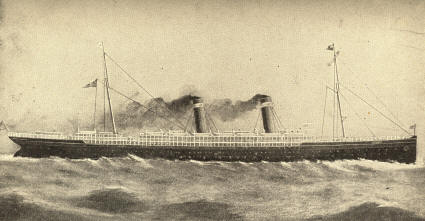
The American Line Steamship St. Louis, launched from the Cramps Docks, November 12. 1894. (554 feet long ,000 tons, and ,000 horse-power.)
A generation earlier one operative made three yards an hour, now he made ten. In the twenty years under survey the annual production of cotton mills rose from two and one-half to three and one-half tons per hand. One man formerly tended forty spindles, now he tended sixty. In 1890 a single operative in America could make cotton cloth enough to supply 1,500 persons.
The improvements in woollen, iron, and miscellaneous manufacturing had perhaps not been quite as great, but were remarkable notwithstanding. Power and automatic machinery were the order of the day. The Corliss engine got 23 per cent. more heat and energy from a given amount of coal than had ever been obtained before it was invented. Instead of the twenty-five days which the first transatlantic steamer required for the passage from America to England, many vessels now went from New York to Liverpool in considerably less than six days, or at an average rate of more than twenty miles an hour. The speed of passenger trains on the main railways had doubled. So had the weight of the freight-car load and the amount of freight which an engine could pull. The newest locomotives weighed nearly or quite one hundred tons each.
336 THE CEMENTED UNION
In 1869 a submarine cable was laid which joined the United States to the continent of Europe. It extended about 3,050 miles, from Duxbury, Mass., to Brest, France, via the Island of St. Pierre, south of Newfoundland. The company owning the cable was chartered by the waning empire of Louis Napoleon. In 1875 a new cable was stretched between the United States and Great Britain. It was called the United States Direct Cable, and at first operated in opposition to the original one. The rates for cable messages were greatly reduced in consequence. The price, once ten dollars a word, fell in anticipation of the competition to fifty cents, and to twenty-five after the competition actually began. The two Anglo-American lines were subsequently united.
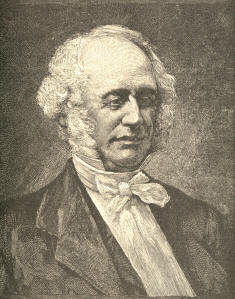
Cornelius Vanderbilt.
The year 1869 witnessed the junction of the Union Pacific with the Central Pacific Railway, forming a continuous railway line between the Atlantic and Pacific shores. The last rail was put down on May 12th, and on the 15th trains began to run.
This work had been in process of construction ever since 1863. It traversed the Rocky Mountain range at an elevation of 8,243 feet above sea-level. The Northern Pacific Railway Company was chartered by Congress in 1864. The road was not completed till August, 1883, nor opened to traffic before September. Its length from Duluth to its then terminus on the Columbia River, Washington, was 1,674 miles. The Southern Pacific and the Atlantic and Pacific, both traversing the Rockies, soon followed. Still another line, the Great Northern, connecting St. Paul with the extreme Northwest, was opened in 1893. The country's total railway mileage in 1885 was 128,967 miles; in 1893 it was 170,607 miles.
In the same years with the opening of these continental lines began the consolidation of the older ones into great systems. The New York Central had already been formed out of sixteen different fragments, but the process of consolidation in a large way may be said to have been instituted by Cornelius Vanderbilt in 1869, when he joined the Lake Shore and Michigan Southern with the New York Central, thus placing under a single administration the entire route from New York to Chicago.
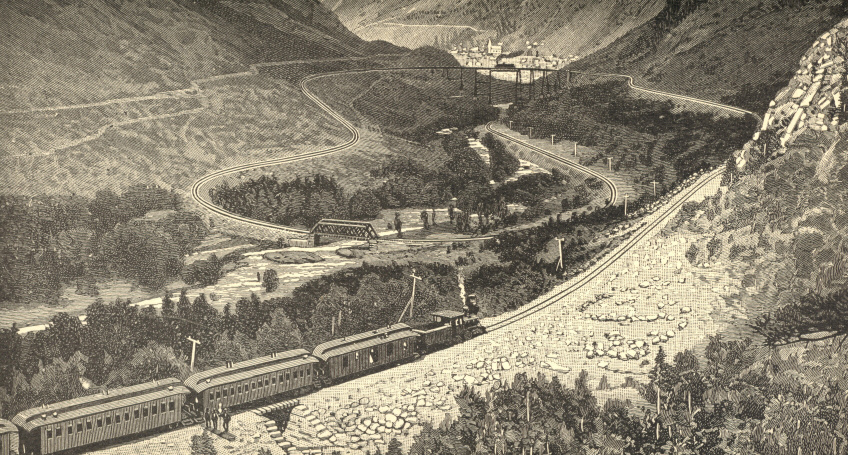
The Big Loop on the Georgetown Branch of the Union Pacific, Colorado.
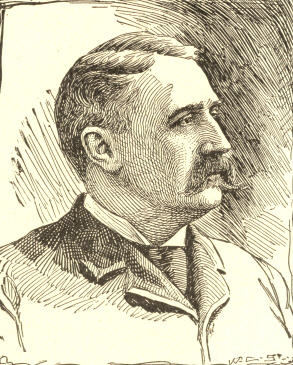
Charles F. Brush.
The first train pierced the Hoosac Tunnel, in Western Massachusetts, February 9, 1875, completing another artery between East and West. The tunnel passed through the Hoosac Mountain, a distance of four miles and three-quarters, and had been in process of boring, though not continuously, about fifteen years.

Moses G. Farmer.
The lighting of large spaces by electricity in a profitable manner may be dated from 1875. The possibility of producing a brilliant light with this fluid had been well known to physicists ever since Sir Humphry Davy's experiments in 1813, but no method of generating the electricity cheaply had hitherto been invented. Utilizing among others the inventions of Dr. C. W. Siemens, Mr. Charles G. Brush, of Cleveland, 0., gave to the world in 1875 his remarkably efficient dynamo or generator, and from that time the illumination of streets and squares by electricity began to be somewhat common.
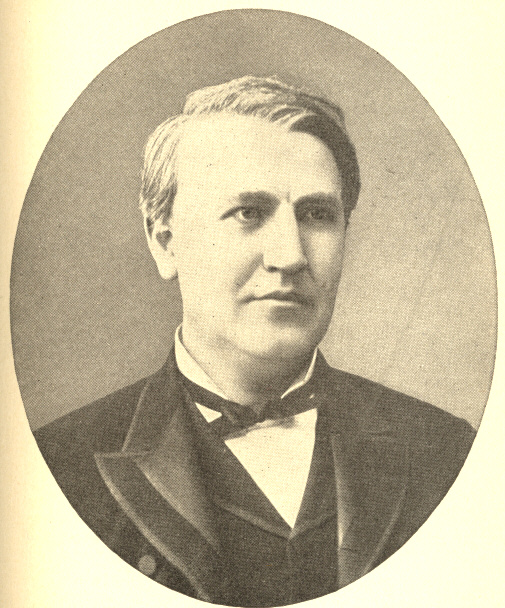
Thomas A. Edison.

The Hoosac Tunnel Lit by Glow Lamps,
after the Plan of the Marr Construction Company.
There was, to be sure another difficulty to be overcome, even for lighting on a grand scale, that of maintaining a steady and continuous light. In this the Jablochkoff candle, used in the Paris streets by 1878, was measurably successful. It was a voltaic arc arrangement, in which, by making each of the two carbon pencils alternately positive and negative, their ends were consumed with equal rapidity and so kept perpetually the same distance apart.
But the voltaic light was too brilliant for a small area. How to divide and subdue it so as to render it suitable for house lighting, was still a difficult problem. Farmer, Sawyer, Mann, and Edison, all attacked it at nearly the same time, going back with singular accord from the voltaic arc principle to that of incandescence in a vacuum. Edison, the prodigy of the century in inventive genius, was the most successful. Besides improving the dynamo, he perfected with little difficulty a cheap vacuum-globe.
After long experimenting he succeeded in the more arduous task of securing an automatic checking of the current before it became hot enough to consume the incandescent carbon.
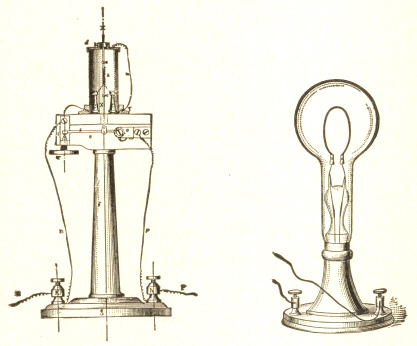
Edison's Platinum Lamp on Carbon Support, 1879.
Edison's Paper Carbon Lamp.
He also found that a large current could be divided into smaller ones by splitting up the conductor into minor filaments. Triumph in household illumination was thus achieved, and when, in October, 1878, the results of Edison's experimenting were announced to the world, gas fell from twelve to twenty per cent.
The alarm was premature, however, since the new illumination did not, after all, prove so satisfactory as to displace the old. It largely did so for streets, factories, and halls, but to no very great extent for residences.
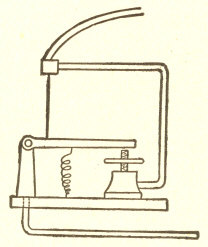
Edison's First Incandescent Platinum Lamp.
The most stupendous engineering work yet accomplished by man, the great bridge spanning East River between Brooklyn and New York, was completed in May, 1883, excavations for its foundations having begun so early as 1870. This wonder of the world was designed by John A. Roebling, and after his death in 1869 finished by his son, W. A. Roebling.
It cost about $16,000,000, two-thirds coming from the city of Brooklyn, one-third from New York. A gigantic stone tower, 277 feet high, was built on each side of the river. Through arched apertures in these toward the top ran the roadway, its ends being 119 feet above the water. The centre of the bridge was supported by four steel wire cables, 16 inches in diameter, which passed from solid masonry structures nearly 1,000 feet away from the water's edge on either shore, up over the two towers, dipping, at the centre of the river, to nearly the level of the roadway. On account of their great weight they had to be braided, strand by strand, in their permanent position. Suspenders from these cables grappled the body of the bridge at frequent intervals. The main span was I,595-1/2 feet long, the entire work about 6,000 feet. There were five passageways--two on the outside for carriages, the next two for cable cars, the middle one for foot passengers. The bridge curved upward from each tower, being at the middle 135 feet above the water in summer, and three feet higher in winter, owing to contraction by the cold. All but the very largest ships sailed under without shortening their masts.
In connection with the great bridge, as likewise in a way possessing an importance for the whole nation, we may mention the ingenious deepening of Hell-gate Channel, East River, by tunnelling beneath the water and using dynamite; and also the introduction of elevated railways in New York City and Brooklyn. This project had been mooted by 1868. Exactly ten years later two sections of railway were open for travel in New York. The first elevated road in Brooklyn began operation in 1885. These new avenues of travel at once became immensely popular. In 1884, no fewer than 250 engines and 800 cars were in use by the New York lines, carrying over 300,000 passengers daily, or about 103,000,000 for the year. Nearly at the same time with the introduction of these roads in New York, new methods of traction for surface street railways, by electricity and by cable, were introduced in various cities of the country, bidding fair soon to do away with horses for this service.

The Brooklyn Bridge, looking up the East River.
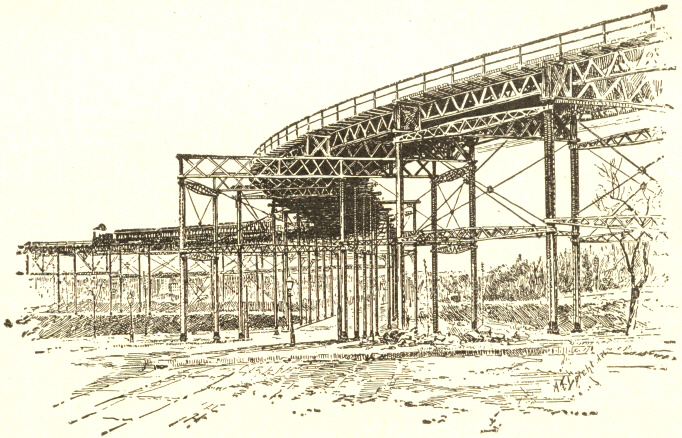
The Manhattan Elevated Railway, New York.
One of the most interesting and valuable inventions of this or any century was that of the telephone, devised by Alexander Graham Bell, and first put to business use in 1877. For ten years Mr. Bell had been experimenting upon the possibility of conveying sound by means of the electric wire. In 1876 he had so far succeeded as to exhibit a pair of his instruments in successful operation at the Philadelphia Centennial Exhibition. In April of the next year the Cambridge Water Board, the Pennsylvania Railroad, and many other corporations ordered the instrument for practical service. From this time the business grew with incredible rapidity. The American Bell Telephone Company was incorporated, and in January, 1886, had in use 330,000 telephones. There were this year in various cities of the United States 752 telephone exchanges. The total length of telephone wires operated by this company was 114,371 miles. In addition to the system which centred in the Bell Company there were several competing telephone establishments in continual litigation with the Bell. The total mileage of telephone wires in the United States in 1887 was estimated at 130,000 miles. There were the same year 170,000 miles of telegraph wire, besides private lines.

Under Side of a Modern Switchboard, showing 2,000 Telegraph Wires.
In 1893, the aggregate length of telegraph lines in the United States open to the public exceeded 210,000 miles. There were, besides, government and private lines to a length vast but not ascertainable. In addition to all this, the Bell Telephone Company, which conducted the main telephone business of the country, owned, the same year, 307,748 miles of wire, which the lines of other companies increased to 440,750 miles.
From this account of our country's material advance after the war we purposely omit mention of the great economic progress at the South, as that has been already reviewed in Chapter IV. We must, instead, notice several events which decidedly checked the prosperity of these years.
So soon as gold had ceased to circulate in 1862, speculation in it began, which was one of the most pernicious results of the depreciation of paper. The ups and downs in the gold price of the greenback from week to week and from day to day during the war were largely due to this cause. In 1869 a clique of speculators in New York thought to realize an immense fortune by cornering gold, a large proportion of the stock east of the Rocky Mountains being known to be in New York City.
By Wednesday, September 22d, they had pushed up the price of gold in greenbacks from 131 to 141, causing a disastrous tumble in stocks and almost a panic. The money market grew tight, and interest enormous. Loans were to be had only on the very best securities. On Thursday gold still advanced, showing that the corner remained solid.

Professor Bell Sending the First Message by Long-distance
Telephone, from New York to Chicago.
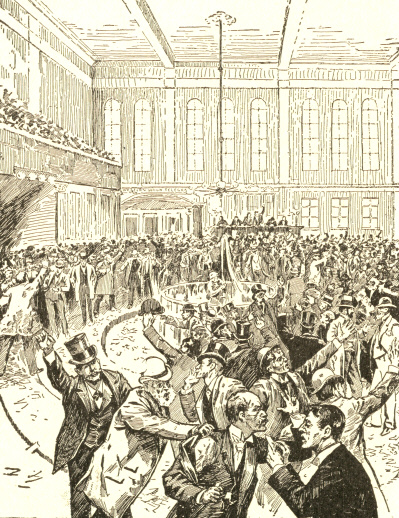
The New York Gold Room on "Black Friday," September 24, 1869.
At the last call it stood at 144; at the first on Friday, September 24th, 105 was the figure. The ring was believed at this time to hold in gold and in contracts to deliver the same, over $100,000,000, while all the gold in New York outside the United States Sub-Treasury was hardly over $10,000,000. Only the Government could break the corner. At eleven o'clock gold was at 155, whence in half an hour it rose to 160, then to 162, then to 164. In the midst of an excitement never paralleled in the Gold Room before or since, it was announced on authority that the Government would sell. The price at once went down to 135, and the power of the clique was instantly broken. This day passed into history under the name of "Black Friday."
The Chicago fire of October, 1871, was the most disastrous yet in the chronicles of our country. It began in the evening of October 8th and raged for over twenty-four hours. According to the best estimates 250 lives were lost, 98,500 persons made homeless, 17,500 buildings consumed, and $192,000,000 worth of property destroyed. The main business portion of the city was included in the tract burned. Thirteen months later the most destructive conflagration that had ever visited Boston swept the district below Washington Street from Summer nearly to State, and eastward to the water's edge, being the most solid business portion of the city. The loss was placed at $75,000,000.

A Scene during the Chicago Fire.
The shocking destruction of wealth by these fires was part cause of the hard times which began in 1873. But others concurred. During 1872 the balance of trade was strongly against the United States. The circulation of depreciated paper money had brought to many an apparent prosperity which was not real, leading to the free contraction of debts by individuals, corporations, towns, cities, and States. An unprecedented mileage of railways had just been constructed. During the half decade ending with 1873, $1,700,000,000 had thus been spent in the country. The supposed wealth of many consisted in the bonds of these roads and of other newly created concerns, as mining and manufacturing corporations. Thus the entire business of the country was on a basis of inflation, and when contraction came by the resumption of specie payments and the demonetization of silver, disaster was inevitable.
In the course of the summer solid values began to be hoarded and interest rates consequently to rise. In September panic came. Credit in business was refused, debtors were pressed for payment, securities were rushed into the market and fell greatly in price, railway stocks from ten to forty per cent., even United States bonds from five to ten.
There was a run upon savings banks, many of which succumbed. For ten days, beginning September 20th, the New York Stock Exchange had to suspend, so dubious was the value of most stock contracts. Manufactured products were little salable, and the prices of agricultural painfully sank. Factories began to run on short time, many closed entirely, many corporations failed. The peculiarity of this crisis was the slowness with which it abated. No date indeed can be set as its term, its evil effects dragging on through years, so that the ill times of 1893-94 may be regarded as the same fever, intermittent in the meantime.
Notwithstanding all these drawbacks, the material progress of the United States for the two decades which we are studying was something enormous. We have no room for details. Our total population by 1880 had swollen to 50,155,783, by 1890 to 62,622,250. The census valuation of our national wealth, which had been for 1860, $16,159,616,068. was, for 1870, $30,068,518,507; for 1880, $43,642,000,000; and for 1890, $65,037,091,197.
The per capita wealth was, according to the census of 1860, $514, by that of 1870, $780, by that of 1880, $870, by that of 1890, $1,036. In 1870 the United States was in wealth the third nation on the globe; in 1880 it had distanced France and stood second. "The country whose population has been developed within two hundred and eighty years, does already one-third of the world's mining, one-fourth of its manufacturing, and one-fifth of its agriculture; and at least one-sixth of the world's wealth is already concentrated in the strip of territory in Central North America which is the home of the United States." These words were written after the census of 1880. Still stronger ones would have been true in 1895.


